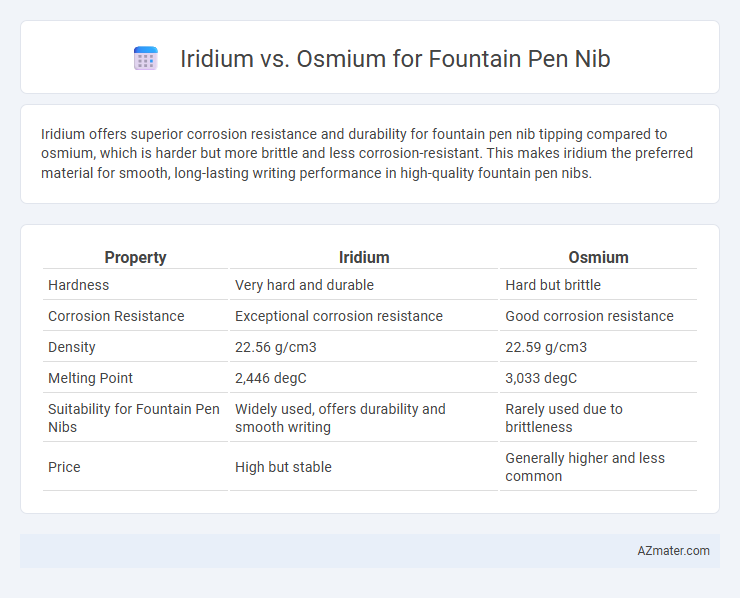Iridium offers superior corrosion resistance and durability for fountain pen nib tipping compared to osmium, which is harder but more brittle and less corrosion-resistant. This makes iridium the preferred material for smooth, long-lasting writing performance in high-quality fountain pen nibs.
Table of Comparison
| Property | Iridium | Osmium |
|---|---|---|
| Hardness | Very hard and durable | Hard but brittle |
| Corrosion Resistance | Exceptional corrosion resistance | Good corrosion resistance |
| Density | 22.56 g/cm3 | 22.59 g/cm3 |
| Melting Point | 2,446 degC | 3,033 degC |
| Suitability for Fountain Pen Nibs | Widely used, offers durability and smooth writing | Rarely used due to brittleness |
| Price | High but stable | Generally higher and less common |
Introduction to Iridium and Osmium in Fountain Pen Nibs
Iridium and osmium are both rare, hard metals used in fountain pen nibs to enhance durability and smooth writing performance. Iridium, known for its exceptional corrosion resistance and hardness, is traditionally alloyed with gold or other metals to protect nib tips from wear and ensure longevity. Osmium, one of the densest natural elements, offers superior hardness and resistance to abrasion, providing a robust alternative for pen nib tips that withstand extensive use while maintaining precise ink flow.
Historical Use of Metals in Fountain Pen Manufacturing
Iridium has been the preferred metal for fountain pen nib tipping since the early 20th century due to its exceptional hardness and corrosion resistance, ensuring durability and smooth writing performance. Osmium, once considered for nibs because of its hardness, fell out of favor primarily due to its brittleness and rarity, presenting challenges in manufacturing and longevity. The historical evolution of fountain pen metals reflects the practical balance between durability and workability, with iridium consistently outperforming osmium in long-term applications.
Chemical Properties: Iridium vs Osmium
Iridium exhibits exceptional corrosion resistance and high hardness, making it ideal for fountain pen nib tips subjected to constant ink flow and friction. Osmium, while extremely dense and hard, tends to oxidize more readily, potentially affecting long-term durability in ink exposure. The chemical stability of iridium alloys ensures superior resistance to wear and ink corrosion compared to osmium, enhancing nib longevity and performance.
Durability and Wear Resistance Comparison
Iridium and osmium are both highly durable metals commonly used in fountain pen nib tipping, with iridium offering superior corrosion resistance and consistent wear performance over time. Osmium is the densest naturally occurring element, providing exceptional hardness and abrasion resistance, but its rarity and brittleness can lead to chipping under heavy use. In terms of longevity and everyday writing durability, iridium-tipped nibs are generally preferred due to their balanced hardness and resilience against wear and ink corrosion.
Writing Smoothness and Performance
Iridium, commonly used in fountain pen nib tipping, provides superior smoothness and consistent ink flow due to its resilience and fine grain structure, ensuring effortless writing experience. Osmium, being one of the hardest metals, offers exceptional durability and wear resistance but may result in a slightly rougher writing surface compared to iridium-tipped nibs. For optimal writing performance, iridium remains the preferred choice, combining smoothness with longevity that meets high standards of pen enthusiasts and professionals.
Corrosion Resistance and Longevity
Iridium offers excellent corrosion resistance due to its stable, inert nature, making it a preferred choice for fountain pen nibs subjected to frequent ink exposure. Osmium, while rare and extremely hard, is prone to oxidation over time, which can compromise nib integrity and reduce longevity. Therefore, iridium's superior corrosion resistance ensures longer-lasting, resilient fountain pen nibs ideal for everyday writing.
Sourcing and Environmental Impact
Iridium, primarily sourced from the recycling of platinum group metals and mining in South Africa and Russia, offers a more sustainable option due to established recycling processes that reduce environmental degradation. Osmium, rarer and less recycled, comes from limited mining operations that often involve environmentally disruptive extraction methods, increasing its ecological footprint. Fountain pen manufacturers favor iridium for nib tipping because its sourcing aligns better with sustainability goals and supply chain stability.
Cost and Availability of Iridium and Osmium Nibs
Iridium fountain pen nibs are more common and cost-effective compared to osmium nibs, primarily due to iridium's greater availability and established use in pen manufacturing. Osmium, a rarer and denser metal, is significantly more expensive, limiting its use in nib production and resulting in lower market availability. Manufacturers favor iridium alloys for their balance of durability, smooth writing, and affordability in high-quality fountain pen nibs.
User Experiences and Brand Preferences
Iridium, favored by brands like Parker and Pilot, is renowned for its smoother writing experience and greater resistance to corrosion, leading to higher user satisfaction in everyday fountain pen use. Osmium, though extremely hard, is less commonly used due to its brittleness, often causing inconsistent ink flow and requiring more frequent maintenance, which many users find inconvenient. Preferred by enthusiasts who prioritize durability, iridium-tipped nibs dominate the market because they strike an optimal balance between smoothness and longevity.
Conclusion: Choosing the Right Metal for Your Nib
Iridium offers excellent corrosion resistance and smooth ink flow, making it ideal for durable, consistent fountain pen nibs. Osmium is one of the hardest and rarest metals, providing exceptional wear resistance but often at a higher cost and limited availability. For most users, iridium strikes a balance between cost, durability, and performance, while osmium suits collectors or enthusiasts seeking premium, long-lasting nib materials.

Infographic: Iridium vs Osmium for Fountain Pen Nib
 azmater.com
azmater.com